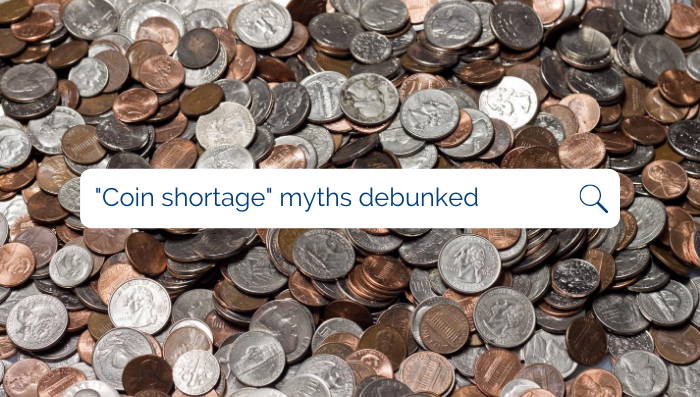
Myth Busting: Coin Shortage
08/01/2020
COVID-19 has affected every aspect of American life. From brick and mortar businesses to how students attend school, the effects are everywhere. Unsurprisingly those changes have trickled down into the very fabric of the American economy with the circulation of money. Or, more specifically, the circulation of coins. Because of this circulation disruption, myths have emerged about the current American “coin shortage.”
Myth: America is running out of coins, hence the “shortage”
The very term “shortage” is part of the perpetuating myths. It isn’t so much a shortage as a disruption in the circulation cycle. Yiming Ma, assistant professor in the finance division of the Columbia Business School, told Forbes that the concept of the coin shortage in itself is not an accurate description. The disruption of the economy because of COVID has caused a disruption in coin circulation.
Ma went on to explain that businesses that rely on coins, like laundromats and even vending machines, weren’t being used during the stay-at-home orders or if the businesses were shut down altogether because of the pandemic. Because these kinds of businesses help redistribute coins back into circulation through the banks, without their coin transfers there has been a significant reduction in coin circulation.
“A disruption is a better way to describe it,” Ma says. “It’s reflecting the fact that, once circulation is resumed, these disruptions will ease out.”
Further, according to the New York Times, Jerome H. Powell, chair of the Fed, told lawmakers in June: “What’s happened is that with the partial closure of the economy, the flow of coins through the economy, it has gotten all — it’s kind of stopped. We’ve been aware of it, we’re working with the Mint to increase supply, we’re working with the reserve banks to get the supply to where it needs to be.”
The U.S. Mint said in late July that there are ways for Americans to help manage this disruption until things get back to normal. Paying in exact change will help return your spare change into circulation, for example. The Mint asks that shoppers start “spending their coins, depositing them or exchanging them” at banks or at a coin deposit kiosk. Coin supply issues can be solved more quickly if everyone does what they can to help.
Myth: The shortage is intentional as a way for America to become a cashless society
Early in July posts began circulating across social media claiming that the current coin shortage was no accident, that the U.S. government is taking steps to eliminate physical money in the country’s economy. But both economic experts and the Federal Reserve have spoken out against this particular myth. The pandemic has caused a significant decrease in in-person purchases resulting in fewer coins in circulation and a decrease in coin minting.
On June 11 the Federal Reserve put out a statement about their strategic coin allocation plan in light of the economic disruption of COVID-19. Despite the current circulation disruption the Fed said circulation will return to normal eventually but, in the near-term, there will be fewer coins circulations between businesses and banks.
According to PolitiFact, “U.S. Mint spokesman Todd Martin told PolitiFact that in the early stages of the coronavirus outbreak, the Mint reduced the number of employees per shift in order to enhance social distancing, leading to a reduction in [the] production of 10% in April and 20% in May. At the same time, reduced sales activity meant retailers were ordering more coins from the Mint because they were receiving fewer of them as people stayed home, he said.”
So while the reduction of coin minting was intentional because of lack of need during the shutdown, the decision was not made to create a cashless society.
Myth: Proponents of Bitcoin want the U.S. economy to become a cashless one
The popularity of this myth is based largely on this article from 2011 that has recently been making its way around social media. The article is in no way related to the current coin disruption in the economy and crypto-currency advocates are not on the hunt to eliminate cash.
Jamie Redman at Bitcoin.com wrote “most crypto supporters, just because they support an electronic currency, do not support the removal of cash money. But there is little anyone can do to stop the government from going cashless.”
Conclusion? Crypto-currency is definitely not behind the coin disruption.
In Conclusion
The result of the temporary coin disruption is that some stores may not be able to issue change or accept cash. But, like much else in 2020 America, the COVID-19 pandemic has made a lot of temporary realities. So, when shopping, be aware that you might need to pay in exact change if paying in cash and remember that this is not so much a “shortage” as it is a circulation disruption.

